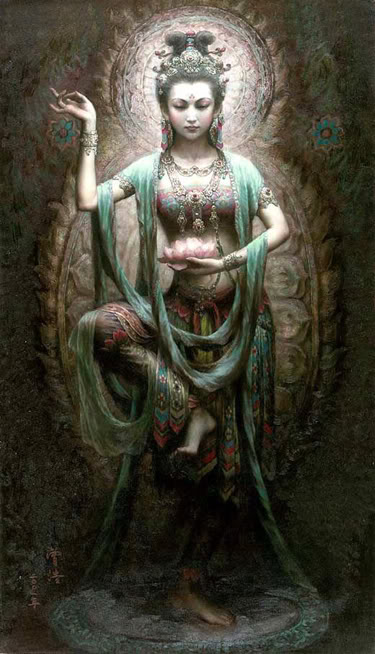Brigit is one of the great goddesses (along with Isis, Ishtar, Hera and Freya) who has been with us for hundreds of thousands of years. Her legends were handed down through the generations in an oral tradition that was eroded and then assimilated into the new faith of Christianity. Despite the fact that she was a diety so high and sacred, hardly any of her mythology was recorded. Brigit is often depicted as a triple goddess. In her solitary form she carries a spear and an orb or globe. Sometimes she is seen wearing a green mantle, which may be a sign of her connection with Faery Folk. In folklore, Brigit means 'fiery arrow', 'bright arrow', or 'the bright one'. 'Fiery arrow' has become a fitting image for Brigit since it conveys the idea of the bright flame that has come to be associated with her, along with a sense of her directness, her ability to get straight to the point and the force of her energy.
As a healer, Brigit taught leechcraft and the properties of healing herbs, and was patroness of dozens of sacred springs and wells said to have healing properties. Many of these springs and wells are still visited today. Sunlight and water were considered to be especially effective in curing ailments of the eyes, which was one of the goddess' specialities. Along with her mantle, any fabric blessed by her was said to have healing effects. She was the first goddess to master the art of weaving, and into the cloth she placed healing threads that still exercise their healing powers centuries later. Brigit is also seen as a fire goddess, a fertility and birth goddess, a smith, a poet and a warrior. She is one of the Great Goddesses of Life and Death. She was goddess of agriculture and household arts such as weaving, dyeing and making beer. She is also credited with inventing whistling as a way to signal to her friends in the darkness.
Red and white are the colors most commonly used for this holiday. White representing the snow of the departing winter and red for the hearthfire or Brigit's eternal flame. White also represents the Maiden goddess and red symbolizes the Mother. You might like to use white tablecloths for your altar with red candles, or like I have done, use a red tablecloth with candles in both red and white. I made a corn dolly, which I posted previously, and have now laid her in the Bride's bed, thus the Crone who guarded the house during the winter is now transformed into the Maiden who awaits the God so that together they may initiate spring. I used a dowel (wand) wrapped in blue and white ribbon to represent the God, who is changing from the babe of Yule into the Youth of Ostara.
Bride's Bed Ritual
On Imbolc eve set the Bride's bed on the fireplace hearth or on your altar. Set incense in front and a white taper candle at either end of the bed. Have the wand nearby. Light the incense and the candles and say:"Welcome the Bride turned from Mother to Maiden;
to rest and prepare for the time of the seed.
Cleansed and refreshed from the labors behind her;
with the promise of spring she lays before me."
"How soon comes the Lord; how quickly he grows!
The season will turn; before we know."
Brigit's Cross is another familiar symbol and was most likely a sun emblem. It may also have represented the four quarters of the year. I made one using white pipe cleaners and tied the ends together with white ribbon. You can also make them in red or a combination of both. Traditionally, Brigit's crosses are made out of reeds, but being I live in the frozen north, pipe cleaners are the way to go. I may harvest some reeds this summer and make the crosses up ahead of time, so that they're ready and available next year.
Now is a good time to start thinking about spring house cleaning and also performing a house cleansing and blessing ceremony. It's also a good time to get rid of all the old stuff that has been cluttering your home and creating negativity. Now would also be a good time to create sacred space (if you haven't done so already), create or recreate your altar and cleanse and consecrate your ritual tools.
Keep your hope alive . . . spring is just around the corner!

















































